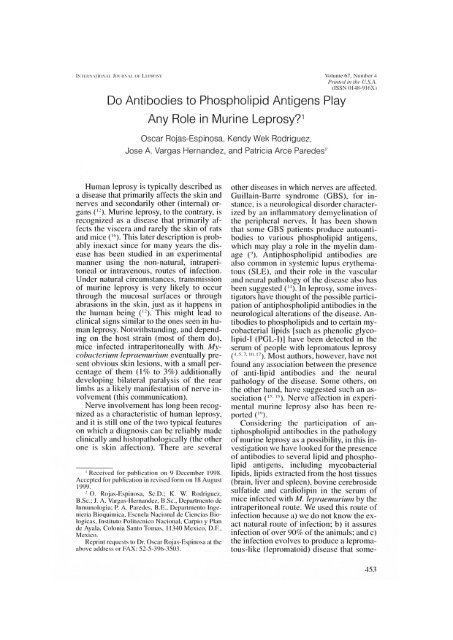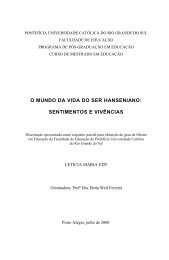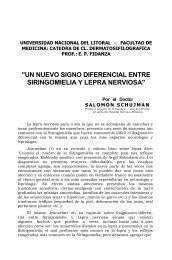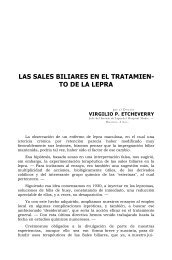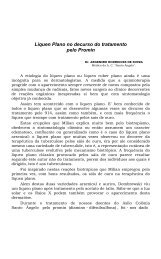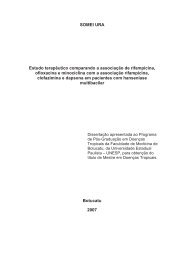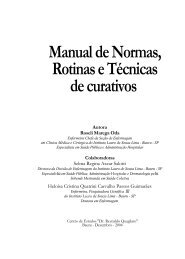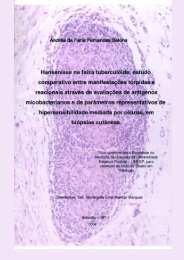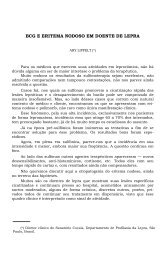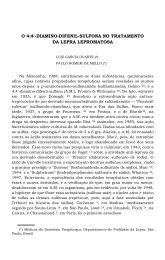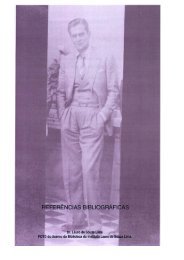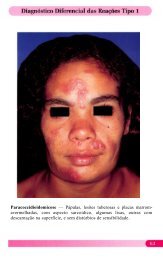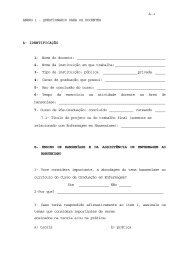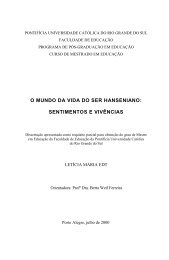Do Antibodies to Phospholipid Antigens Play Any Role in ... - Index of
Do Antibodies to Phospholipid Antigens Play Any Role in ... - Index of
Do Antibodies to Phospholipid Antigens Play Any Role in ... - Index of
Create successful ePaper yourself
Turn your PDF publications into a flip-book with our unique Google optimized e-Paper software.
IN1ERN. \ II( )X. \i JOURNAI Ol• Li .110 >SN' ^<br />
Volume 67. Nuniber 4<br />
P/ <strong>in</strong>ted^the (1.S.,1.<br />
1ISSN 0148-916X)<br />
<strong>Do</strong> <strong>Antibodies</strong> <strong>to</strong> <strong>Phospholipid</strong> <strong>Antigens</strong> <strong>Play</strong><br />
<strong>Any</strong> <strong>Role</strong> <strong>in</strong> Mur<strong>in</strong>e Leprosy?'<br />
Oscar Rojas-Esp<strong>in</strong>osa, Kendy Wek Rodriguez,<br />
Jose A. Vargas Hernandez, and Patricia Arce Paredes?<br />
Human leprosy is typically described as<br />
a disease that primarily affects the sk<strong>in</strong> and<br />
nerves and secondarily olhei (<strong>in</strong>terna!) organs<br />
(''). Mur<strong>in</strong>e leprosy, <strong>to</strong> the contrary, is<br />
recognized as a disease that primarily affects<br />
the viscera and rarely the sk<strong>in</strong> <strong>of</strong> rats<br />
and mice Cl. This later description is probably<br />
<strong>in</strong>exact s<strong>in</strong>ce for many years the discase<br />
has been studied <strong>in</strong> an experimental<br />
man ner us<strong>in</strong>g the non-natural, <strong>in</strong>traperi<strong>to</strong>neal<br />
or <strong>in</strong>travenous, routes <strong>of</strong>. <strong>in</strong>fection.<br />
Under natural circumstances, transmission<br />
<strong>of</strong> mur<strong>in</strong>e leprosy is very likely <strong>to</strong> Occur<br />
through the mucosal surfaces or through<br />
abrasions <strong>in</strong> the sk<strong>in</strong>, just as it happens<br />
the human be<strong>in</strong>g (''). This might lead <strong>to</strong><br />
cl<strong>in</strong>icai signs similar <strong>to</strong> the ones seen <strong>in</strong> human<br />
leprosy. Notwithstand<strong>in</strong>g, and depend<strong>in</strong>g<br />
on the host stra<strong>in</strong> (most oí them do),<br />
mice <strong>in</strong>fected <strong>in</strong>traperi<strong>to</strong>neally with Mvcebucterium<br />
/epruemurium eventually present<br />
obvious sk<strong>in</strong> lesions, with a small percentage<br />
<strong>of</strong> them (1(/ <strong>to</strong> 3%) additionally<br />
develop<strong>in</strong>g bilateral paralysis <strong>of</strong> the rear<br />
limbs as a likely manifestation <strong>of</strong> nerve <strong>in</strong>volvement<br />
(this communication).<br />
Nerve <strong>in</strong>volvement lias long been recognized<br />
as a characteristic <strong>of</strong> human leprosy,<br />
and it is still one <strong>of</strong> the two typical features<br />
ou which a .diagnosis can be reliably made<br />
cl<strong>in</strong>ically and his<strong>to</strong>pathologically (the other<br />
one is sk<strong>in</strong> affection). There are severa!<br />
' Reeeived for publication ou 9 1)eeenther 1998.<br />
Aceepted for publication <strong>in</strong> revised forni ou 18 August<br />
1999.<br />
= O. 1Zo1as-Esp<strong>in</strong>osa, Se.!).; K. W.<br />
11.Sc.; J. A. Vareas-llernandet, 11.Se., 1)ep.trtnierào de<br />
In<strong>in</strong>unologia. P.- A. Paredes, B.F., 1)epartnien<strong>to</strong><br />
nicria Bioquilnica, [senda Nacional de Ciencias Bio-<br />
1o:2re:is, Institu<strong>to</strong> Politeenieo Nacional, Carpiu y Plan<br />
de- Ayala, Colori ia San<strong>to</strong> Tontas, 11340 Mexieo, 1).F.,<br />
Mexeu.<br />
Itepr<strong>in</strong>t requests <strong>to</strong> Dr. Oscar Rojas-Fsp<strong>in</strong>oszi at the<br />
ahove address or FAX: 52-5-396-3503.<br />
other diseases <strong>in</strong> which nerves are affected.<br />
Guilla<strong>in</strong>-Barre syndrome (GBS), for <strong>in</strong>stance,<br />
is a neurological disorder characterized<br />
by an <strong>in</strong>tlamma<strong>to</strong>ry demyel<strong>in</strong>ation <strong>of</strong><br />
the peripheral nerves. It lias been shown<br />
that some G13S patients produce au<strong>to</strong>antibodies<br />
<strong>to</strong> var<strong>in</strong>os phospholipid antigens,<br />
which may play a role <strong>in</strong> the myel<strong>in</strong> damage<br />
("). Antiphospholipid antibodies are<br />
also com moo <strong>in</strong> systemic lupus erythema<strong>to</strong>us<br />
(SLE), and their role <strong>in</strong> the vascular<br />
and neural pathology <strong>of</strong> the disease also<br />
beco suggested (")• In leprosy, some Uivesti,ga<strong>to</strong>rs<br />
have thought <strong>of</strong> the possible participation<br />
<strong>of</strong> antiphospholipid antibodies <strong>in</strong> the<br />
neurological alterations <strong>of</strong> the disease. <strong>Antibodies</strong><br />
<strong>to</strong> phospholipids and <strong>to</strong> certa<strong>in</strong> mycobacterial<br />
1 ipids such as phenolic glyco-<br />
1ipid-1 (PGL-I)1 have beco detecte(' <strong>in</strong> the<br />
serum <strong>of</strong> people with leproma<strong>to</strong>us leprosy<br />
(4.5.7. 'R 17). Most authors, however, have not<br />
found any association between the presence<br />
<strong>of</strong> anti-lipid antibodies and the neural<br />
pathology <strong>of</strong> the disease. Some others, ou<br />
the other hand, have suggested such an association<br />
''). Nerve affection nu experimental<br />
mur<strong>in</strong>e leprosy also lias been reported<br />
Consider<strong>in</strong>g the participation <strong>of</strong> antiphospholipid<br />
antibodies <strong>in</strong> the pathology<br />
<strong>of</strong> mur<strong>in</strong>e leprosy as a possibility, <strong>in</strong> this <strong>in</strong>vestigation<br />
we have looked for the presence<br />
<strong>of</strong> antibodies lo several lipid and phospholipid<br />
antigens, <strong>in</strong>clud<strong>in</strong>g mycobacterial<br />
lipids, lipids extracted from the host tissues<br />
(bra<strong>in</strong>, liver and spleen), bov<strong>in</strong>e cerebroside<br />
suntide and cardiolip<strong>in</strong> <strong>in</strong> the serum <strong>of</strong><br />
mice <strong>in</strong>fected with Al. lepracmurium by the<br />
<strong>in</strong>traperi<strong>to</strong>neal rotule. We used this rotule <strong>of</strong><br />
<strong>in</strong>fection because a) we do not know the exact<br />
natural route <strong>of</strong> <strong>in</strong>fection; b) it assues<br />
<strong>in</strong>fection <strong>of</strong> over 90% <strong>of</strong> the animais; and c)<br />
the <strong>in</strong>fection evolves <strong>to</strong> produce a leproma<strong>to</strong>us-like<br />
(lepr)ma<strong>to</strong>id) disease that some-<br />
453
454^ International Journal ()/. Leprosv ^ 1999<br />
what resembles leproma<strong>to</strong>us leprosy <strong>in</strong><br />
humans.<br />
MATERIALS AND METHODS<br />
Chemicals. Most chemicals were purchased<br />
from Sigma Chemical Co., St.<br />
Louis, Missouri, U.S.A.; exceptions are <strong>in</strong>dicated.<br />
Animais and their <strong>in</strong>fection. Female,<br />
alb<strong>in</strong>o, 2-month old, NIH mice were <strong>in</strong>fected<br />
with 5 x 107 cells <strong>of</strong> M. leprae<strong>in</strong>urium<br />
(Hawaiian stra<strong>in</strong>) by the <strong>in</strong>traperi<strong>to</strong>neal<br />
route. Bacilli had been freshly isolated<br />
from the spleens <strong>of</strong> heavily <strong>in</strong>fected<br />
NIH 'Ince by us<strong>in</strong>g the whole procedure <strong>of</strong><br />
Prabhakaran (") and the Percoll step <strong>of</strong><br />
Draper () <strong>in</strong> that order. Six months after <strong>in</strong>oculation,<br />
the mice were sacriticed under<br />
chlor<strong>of</strong>orm anesthesia and exsangu<strong>in</strong>ated<br />
by heart puncture. Blood was used as the<br />
source <strong>of</strong> sentiu for the search ffir antibodies<br />
<strong>to</strong> several lipid species. Two mice that<br />
had developed paralysis <strong>of</strong> the rear limbs<br />
and 14 animais that had not were <strong>in</strong>cluded<br />
<strong>in</strong> the study (globally, paralysis affected<br />
I %-3% <strong>of</strong> the M. lepraemuriu<strong>in</strong> - <strong>in</strong>fected<br />
animais). The Figure shows a palsied<br />
mouse.<br />
Sonieally extraeted mycobacterial<br />
antigens. A 20% suspension (v/v) <strong>of</strong> highly<br />
purified bacilli <strong>in</strong> sal<strong>in</strong>e-borate solution (p1-1<br />
8.4) was subjected <strong>to</strong> disruption <strong>in</strong> a sonifier<br />
(Sonifier, Danbury, Connecticut,<br />
U.S.A.) for 15 m<strong>in</strong> (5 x 3-m<strong>in</strong> pulses) at 80<br />
watts. The sonicate was then centrifuged at<br />
15,000 x g x 10 m<strong>in</strong>, the supernatant collected,<br />
and 1 mM N-ethyl maleimide and I<br />
mM p-phenyl sulfonyl fluoride were added.<br />
Sterilized through a 0.45-Lm Millipore<br />
membrane, the supernatant was divided<br />
<strong>in</strong><strong>to</strong> 1.0-ml aliquots and kept frozen at<br />
—20°C until used.<br />
M. lepraenwrium-derived lipids. Mycobacterial<br />
lipids were prepared accord<strong>in</strong>g<br />
<strong>to</strong> Folch, et al. () for whole lipids and<br />
Luna, et al. (") for lipids <strong>of</strong> low, <strong>in</strong>termediate,<br />
and high polarity.<br />
Lipids from normal tissue. Lipids were<br />
prepared from the liver and spleen <strong>of</strong> normal<br />
animais accord<strong>in</strong>g <strong>to</strong> Folch, et al. (5)•<br />
Lipids <strong>of</strong> the bra<strong>in</strong> were obta<strong>in</strong>ed by thoroughly<br />
ff<strong>in</strong>d<strong>in</strong>g a mouse bra<strong>in</strong> with about<br />
I() ml <strong>of</strong> absolute ethanol <strong>in</strong> a glass-tissue<br />
homogenizer. After centrifug<strong>in</strong>g the ho-<br />
THE FiGuRE. Some NIH Iniee (1%-3%) <strong>in</strong>fected<br />
with AI. lepraemurium evenlually develop bilateral<br />
paralysis <strong>of</strong> the rear I<strong>in</strong>ihs. Paralysis appears late <strong>in</strong> the<br />
<strong>in</strong>tection and does not ai icei the fro<strong>in</strong><br />
mogenate, the ethanolic extract was collected<br />
with no further trezttment <strong>in</strong> a small,<br />
wide-mouth, screw-cap flask and the alcohol<br />
allowed <strong>to</strong> evaporate ai 37°C. This led<br />
<strong>to</strong> a \vhitish waxy material that was kept <strong>in</strong><br />
a tirhtly closed tlask at —20°C until used.<br />
Cardiolip<strong>in</strong>. Cardiolip<strong>in</strong> was obta<strong>in</strong>ed<br />
from Si_zittzt (C 1649) as an ethanolic solution<br />
conta<strong>in</strong><strong>in</strong>g 5.0 mg cardiolip<strong>in</strong> per ml.<br />
Sulfatide. The sulfatide used was a cerebroside<br />
sulfate from bov<strong>in</strong>e bra<strong>in</strong> (S 1006;<br />
Sigma).<br />
Enzv<strong>in</strong>e-l<strong>in</strong>ked <strong>in</strong>ununosorbent assays<br />
(ELISÃs). ELISAs were performed <strong>in</strong><br />
maxisorp plates (Nunc, Roskilde, Denmark<br />
) accord<strong>in</strong>g <strong>to</strong> standard procedures.<br />
prote<strong>in</strong> antigens (sonically extrzicted)<br />
were adjusted <strong>to</strong> 20 tg per ml <strong>of</strong><br />
sal <strong>in</strong>e-borate buffer (SBB, pH 8.4, conta<strong>in</strong><strong>in</strong>g.<br />
0.309 g soclium tetraborate per liter <strong>of</strong><br />
0.15 M NaCI) and distributed <strong>in</strong> 100-pl<br />
aliquots (2 pg prote<strong>in</strong>) per 'e1 1. P1 ates were<br />
<strong>in</strong>cubated for 2 lir at 37°C and filen<br />
overnight at 4°C. Mycobacterial lipids, tissue<br />
lipid antigens and bov<strong>in</strong>e bra<strong>in</strong> sul fatide<br />
\vere first clissolved <strong>in</strong> chlor<strong>of</strong>orm (1 uni,<br />
lipid per 0.1 ml chlor<strong>of</strong>orm) and then di-luted<br />
<strong>in</strong> absolute ethanol <strong>to</strong> 20 pg per ml;<br />
cardiolip<strong>in</strong> was directly diluted <strong>in</strong> absolute<br />
ethanol <strong>to</strong> 20 j.tg per ml. One hundred itt 1 <strong>of</strong><br />
Lhe lipids were distributed per well <strong>in</strong> the<br />
ELISA plates, and the plates were left<br />
overnight at 37°C <strong>to</strong> allow evaporation <strong>of</strong><br />
the solvent.<br />
Then the proceclure was similar for both<br />
Lhe lipid and prote<strong>in</strong> antigens and <strong>in</strong>cluded:<br />
a) wash<strong>in</strong>g <strong>of</strong> the wells (twice) with SBB;<br />
h) block<strong>in</strong>g <strong>of</strong> the wells with 150 pl <strong>of</strong> 2%
67, 4^Rojas-Esp<strong>in</strong>osa, et al.: Ab <strong>to</strong> <strong>Phospholipid</strong>s iii Mur<strong>in</strong>e Leprosy^455<br />
TABU.^<strong>Antibodies</strong> <strong>to</strong> mycobacterial<br />
prote<strong>in</strong> and lipid antigens <strong>in</strong> the serum<br />
healthy or M. lepraemurium (MLM)-<strong>in</strong>fected<br />
tnice.<br />
Ilealthy MLM-<br />
MLM- l<strong>in</strong>ce (II) mice (M) p Value'<br />
antigen (N= 16) (N = 16) vs M)<br />
Prote<strong>in</strong>s 0.034 ± 0.024 1.436 ± 0.150 0.05'<br />
= Low polarity 1ipids.<br />
= Inter<strong>in</strong>ediate polarity lipids.<br />
111)1. =11igli polarity lipids.<br />
Mean value ± standard error <strong>of</strong> absorbencies (492 um) from three experiments sei <strong>in</strong> triplicate. Values were<br />
corrected by subtraet<strong>in</strong>g the <strong>in</strong>ean absorbencies <strong>of</strong> wells only treated with ethanol (0.104 for healthy miee, 0.048<br />
for MLN1-<strong>in</strong>feeted<br />
Stuclent 1 test.<br />
' Mann-Whitney U test.
456^ International lournal Leprosy^ 1999<br />
TABLE 3. Isot.yes^lepraemuritim<br />
antibodies <strong>in</strong> <strong>in</strong>ur<strong>in</strong>e<br />
Antigen<br />
Antibody class<br />
IgM IgG<br />
p Value<br />
Prote<strong>in</strong>s 0.300 ± 0.191 0.500 ± 0.213 0.05'<br />
I ..ipids 0.600 ± 0.136 0.262 ± 0.100 0.5'<br />
"Mean absorbency ± standard error (0I)U ai 492 uni) <strong>of</strong> assays sei iii triplicate. Values were corrected hy subtrai:l<strong>in</strong>g<br />
the <strong>in</strong>ean absorbeney <strong>of</strong> wells treated svith only ethanol.<br />
Mann-Whitney II test.<br />
' Student t test.
67, 4^Rojas-Esp<strong>in</strong>osa, et ai.: Ah <strong>to</strong> Pho.spholipids ia Mur<strong>in</strong>e Leprosy^457<br />
T-cell responses, be<strong>in</strong>g CD1c-restricted<br />
T-ceill<strong>in</strong>es, abie <strong>to</strong> recognize mycobacterial<br />
lipid antigens ('). In the mouse, molecules<br />
analogous <strong>to</strong> CD1 have been described<br />
but their role has not been (yet) fully explored.<br />
A similar mur<strong>in</strong>e CD1c-molecule<br />
might participate <strong>in</strong> the presentation <strong>of</strong> mycobacterial<br />
lipid antigens <strong>to</strong> CD1-restricted<br />
T cells, but the consequence <strong>of</strong> this <strong>in</strong>teraction<br />
<strong>in</strong> regard <strong>to</strong> the ciass <strong>of</strong> immunogiobul<strong>in</strong><br />
(IgG or IgM) fiivored is not yet known.<br />
Regardiess <strong>of</strong> the high leveis <strong>of</strong> antibodies<br />
<strong>to</strong> mycobacterial lipids <strong>in</strong> M. lepraemurium<br />
-<strong>in</strong>fected mice, these animais did<br />
not contam antibodies reactive <strong>to</strong> non-mycobacterial<br />
lipids such as those isolated<br />
from the liver, spleen and bra<strong>in</strong> <strong>of</strong> normal<br />
mice, flor antibodies <strong>to</strong> cardiolip<strong>in</strong>. At first<br />
sight, this wotdd seem a contradic<strong>to</strong>ry result<br />
<strong>in</strong> light <strong>of</strong> the reports ou human leprosy<br />
that <strong>in</strong>dicate a high frequency <strong>of</strong> antibodies<br />
<strong>to</strong> lipids <strong>of</strong> the nervous system (4'5) and <strong>to</strong><br />
cardiolip<strong>in</strong> (7.1"), both lipid preparations<br />
rich <strong>in</strong> phospholipids. Our f<strong>in</strong>d<strong>in</strong>gs, however,<br />
are <strong>in</strong> agreement with the practically<br />
null cl<strong>in</strong>icai <strong>in</strong>voivement <strong>of</strong> !terve damage<br />
<strong>in</strong> mur<strong>in</strong>e ieprosy. Even those animais that<br />
showed bilateral paralysis <strong>of</strong> the rear limbs<br />
(2 out <strong>of</strong> the 16 tested) lacked antibodies <strong>to</strong><br />
non-mycobacterial lipids.<br />
Although anticardiolip<strong>in</strong> and ant<strong>in</strong>eural<br />
antibodies are frequently present <strong>in</strong> multibacillary<br />
(MB) and less frequentiy <strong>in</strong> paucibacillary<br />
(PB) leprosy, their rise not always<br />
correlates with cardiovascular <strong>in</strong>volvement,<br />
bacterial <strong>in</strong>dex, active neuritis, or nerve enlargement<br />
Others, however, have<br />
found that MB patients ais() have elevated<br />
leveis <strong>of</strong> IgM antibodies <strong>to</strong> cerebroside sulfatide,<br />
and that these antibodies fell at the<br />
onset <strong>of</strong> erythema nodosum leprosum, suggest<strong>in</strong>g<br />
a participation <strong>of</strong> these antibodies <strong>in</strong><br />
the pathology <strong>of</strong> reactional leprosy Our<br />
data, however, do not reveal the presence <strong>of</strong><br />
significant leveis <strong>of</strong> antibodies <strong>to</strong> cerebroside<br />
sulfatide <strong>in</strong> the sera <strong>of</strong> M. lepraemurhon-<strong>in</strong>fected<br />
animais (nor <strong>in</strong> the sera <strong>of</strong><br />
normal animais).<br />
Thus, au<strong>to</strong>immunity <strong>to</strong> lipid antigens <strong>in</strong><br />
mur<strong>in</strong>e leprosy does not seem <strong>to</strong> be a feature<br />
<strong>of</strong> the disease, this correiat<strong>in</strong>g with the<br />
lack <strong>of</strong> nerve <strong>in</strong>volvement <strong>in</strong> this illness.<br />
Bilateral paralysis observed <strong>in</strong> some animais<br />
(1% <strong>to</strong> 3%) <strong>in</strong>fected with M. leprae-<br />
nuirium might <strong>in</strong>dicate active parasitation<br />
<strong>of</strong> nerves rather than a consequence <strong>of</strong> au<strong>to</strong>immunity.<br />
This possibility, however, deserves<br />
further <strong>in</strong>vestigation.<br />
SUMMARY<br />
In order <strong>to</strong> know whether antibodies <strong>to</strong><br />
phospholipids and other host lipids piay a<br />
role <strong>in</strong> the pathology <strong>of</strong> mur<strong>in</strong>e leprosy, we<br />
looked for the presence <strong>of</strong> antibodies <strong>to</strong> cardiolip<strong>in</strong>,<br />
cerebroside sulfatide, and <strong>to</strong> lipids<br />
extracted from normal mur<strong>in</strong>e spleen, liver<br />
and bra<strong>in</strong> <strong>in</strong> the sera <strong>of</strong> mice bear<strong>in</strong>g a<br />
6-month <strong>in</strong>fection with Mycobacterium lepraenzurium.<br />
We ais() looked for the presence<br />
<strong>of</strong> antibodies <strong>to</strong> lipids isolated from M.<br />
lepraetnuriutn. We found that ali <strong>of</strong> the 16<br />
animais exam<strong>in</strong>ed conta<strong>in</strong>ed high leveis <strong>of</strong><br />
antibodies <strong>to</strong> the mycobacterial lipids <strong>of</strong> <strong>in</strong>termediate<br />
polarity (mostly glycolipds) but<br />
none <strong>of</strong> them had antibodies <strong>to</strong> the other<br />
lipids tested, <strong>in</strong>clud<strong>in</strong>g those isolated from<br />
mouse liver, spleen and bra<strong>in</strong>, bov<strong>in</strong>e<br />
cardiolip<strong>in</strong> and sulfatide, nor any significant<br />
leveis <strong>of</strong> antibodies <strong>to</strong> mycobacterial lipids<br />
<strong>of</strong> high or low polarity. The <strong>in</strong>fected animais<br />
ais() had high levels <strong>of</strong> antibodies <strong>to</strong><br />
antigens sonically extracted from the microorganism.<br />
<strong>Antibodies</strong> <strong>to</strong> the socially extracted<br />
antigens (mostiy prote<strong>in</strong>s) were<br />
ma<strong>in</strong>ly IgG, while antibodies <strong>to</strong> the lipid<br />
antigens were predom<strong>in</strong>antiy IgM. Despite<br />
the low but signiticant percentage (1%-3%)<br />
<strong>of</strong> <strong>in</strong>fected animais develop<strong>in</strong>g bilateral<br />
paralysis <strong>of</strong> the rear limbs, au<strong>to</strong>immunity<br />
(due <strong>to</strong> antibodies <strong>to</strong> phospholipids and<br />
other host lipids) does not seem <strong>to</strong> be a feature<br />
<strong>of</strong> mur<strong>in</strong>e leprosy.<br />
RESUMEN<br />
Para saber si los anticuerpos contra fosfolípidos y<br />
otros lípidos dei buésped juegan algún papel en la pa<strong>to</strong>loj„!ía<br />
de la lepra mur<strong>in</strong>a, <strong>in</strong>vestigamos la presencia<br />
de anticuerpos contra cardiolip<strong>in</strong>a y cerebrúsido-sulfatido,<br />
y contra lípidos de hígado, bazo y cerebro de<br />
ratón normal, eu cl suem de ra<strong>to</strong>nes con 6 meses de <strong>in</strong>fección<br />
por Alycobacterium lepmenturium (MEM).<br />
También buscamos la presencia de anticuerpos contra<br />
lípidos aislados de MEM. Los 16 animales estudiados<br />
contuvieron niveles elevados de anticuerpos contra los<br />
lípidos de NI LM de polaridad <strong>in</strong>termedia (glicolípidos,<br />
en su mayoría), pero n<strong>in</strong>gtmo de ellos tuvo niveles significativos<br />
de anticuerpos contra los otros lípidos usados<br />
en cl estudio, Ileiuyendo los lípidos de hígado,<br />
bazo y cercbro de ralou, cardiolip<strong>in</strong>a y sulbitido. Los
458^ Interiunional Journal <strong>of</strong> Leprosy^ 1999<br />
animales <strong>in</strong>fectados tampoco tuvieron niveles significativos<br />
de anticuerpos contra los lípidos micobacterianos<br />
de alta y de haja polaridad. pero sí tuvieron cant idades<br />
elevadas de anticuerpos contra los antígenos liberados<br />
por sonicación del microorganismo (pr<strong>in</strong>cipalmente<br />
proteínas). Los anticuerpos contra los antígenos proteicos<br />
lucrou <strong>in</strong>ziyoritariamente de la clase IgG um ientras<br />
que los anticuerpos contra los antígenos lipídicos<br />
fueron predom<strong>in</strong>antemente 1gM. No obstante que on<br />
porcentaje bajo pero sig.nificativo (1-3C/1 ) de los uni<strong>in</strong>ales<br />
<strong>in</strong>fectados desarrollan parálisis bilateral de las<br />
extremidades traseras, Ia au<strong>to</strong><strong>in</strong>nutnidad (por atuicuerpos<br />
contra fosfolípidos y otros lípidos del huésped)<br />
no parece ser t<strong>in</strong>a característica de la lepra muri na.<br />
RÉSUMÉ<br />
Ett vue de savoir si les anticorps contre les phospholipides<br />
et atares lipides de l'hôte jouent nu rõle<br />
dans la pathologie de Ia lèpre imante, nous avons exarn<strong>in</strong>é,<br />
dans le sérom de souris <strong>in</strong>fectées depois 6 mois<br />
par Mscobacterium lepraenturium. Ia présence d'anticorps<br />
contre Ia cardiolip<strong>in</strong>e, les cérébrosides sollatés et<br />
les lipides extraits à partir de la rate, do fole et du<br />
cerveatt de souris norrnales. Nous avons également<br />
recherché la présence d'anticorps contre des lipides<br />
isolés à partir de Mycobacterium lepraenuirium. Nous<br />
avons trouvé, chez les 16 souris exam<strong>in</strong>ées, de fort<br />
taux d'anticorps contre les lipides mycobactériens de<br />
polarité <strong>in</strong>termédiaire (pr<strong>in</strong>cipalement des glycolipides).<br />
Cependant. aucun de ces animattx n'avait d'anticorps<br />
contre les atares lipides testés tels ceux isolés de<br />
Ia rate, do foie et do cerveau de souris normale, la cardiolip<strong>in</strong>e<br />
bov<strong>in</strong>e et cérébrosides sulfatés. a<strong>in</strong>si que une<br />
absence de niveaux significatifs d'anticorps contre les<br />
lipides de polarité haute ou basse. Les animaux <strong>in</strong>fectés<br />
avaient aussi de haut niveaux d'anticorps contre les<br />
anti)._!ènes extraits des micro-organismes par ultrason<br />
aux ultrasons. Les anticorps dirigés contre les antigènes<br />
extrait par ultrason (pr<strong>in</strong>cipalement des proté<strong>in</strong>es)<br />
étaient pr<strong>in</strong>cipalement des IgG, tandis que les anticorps<br />
dirigés contre les antigènes lipidiques étaient<br />
pr<strong>in</strong>cipalement des IgN1. En dépit do pourcentage bus<br />
mais signilicatif ( I (7e-3c/e) d'animattx <strong>in</strong>fectés présentant<br />
des paralysies bilatérales des pattes arrières,<br />
l'au<strong>to</strong>-immunité (doe à des anticorps dirigés contre les<br />
phospholipides et autres lipides de l'hôte) ne semble<br />
pas être une caractéristique de Ia lèpre !mo<strong>in</strong>e.<br />
Acknowledgment. This study is part <strong>of</strong> a research<br />
project supported by CONACYT (26427-M: "La lepra<br />
li<strong>to</strong>r<strong>in</strong>a como modelo de estudio de la lepra humana")<br />
and by the Dirección de Estudios de Posgrado e Investigación<br />
del I.P.N. (DEP1 970347 and DEPI<br />
970342). We thank Dr. E. Ramírez-San Juan for bis assistance<br />
<strong>in</strong> the statistical treatment <strong>of</strong> the data and Dr.<br />
S. Estrada-Parra for his help when difficult times had<br />
come. P. A.-P. is a fellow <strong>of</strong> COFAA and IPN; O. R.-E.<br />
is a fellow <strong>of</strong> COFAA. IPN. and Sistema Nacional de<br />
Investigadores, México.<br />
REFERENCES<br />
1. BECKN1AN, E. M., MELIÁN, A., BEDAR, S. M.,<br />
SIEGLIN, P. A., CIINITERJEE, D., Ftiitt,oNG, S. T.,<br />
NININUNIO10, R., Rossi', J. P., MoDLIN, R. L. and<br />
Poacilii, S. A. CI)Ic restricts responses <strong>to</strong><br />
mycobacteria-specitic T cells; evidence for omitigen<br />
presentation by a second member <strong>of</strong> the hwman<br />
CD1 Lonily. J. Inummol. 157 (1996)<br />
2795-2803.<br />
2. BLNI)i.i.A(.. A. CD I : present<strong>in</strong>g unusual antigens<br />
<strong>to</strong> unosual T lymphocytes. Science 269 (1995)<br />
185-186.<br />
3. CARD1.1.t., S., TANtazi, S., ClIAN, M., KORNENBLRG,<br />
M., BENOIST, C. and MAritis, D. CD1-restricted<br />
CD4+ T cens <strong>in</strong> major his<strong>to</strong>compatibility com plex<br />
class II-deficient <strong>in</strong>ice. J. Exp. Med. 182 (1995)<br />
993-1004.<br />
4. DLSIKAN, P., PARKAti0, O. and NARANG, P. The<br />
role <strong>of</strong> antiperipheral 'terve antibodies iii nerve<br />
damage <strong>in</strong> leprosy. Lepr. Rev. 65 (1994) 222-230.<br />
5. DfsikAN, E. PARKASII, O. and NARANG, P. <strong>Role</strong> <strong>of</strong><br />
ant<strong>in</strong>ettral antibodies <strong>in</strong> perpettiation <strong>of</strong> a pre-exist<strong>in</strong>g<br />
peripheral !terve damage <strong>in</strong> leprosy. Indian<br />
J. Lepr. 67 (1995) 293-300.<br />
6. DRAPLR, P. Purification <strong>of</strong>itlycobacterium leprae.<br />
Report <strong>of</strong> the lifth Meet<strong>in</strong>g <strong>of</strong> the Scientific Work<strong>in</strong>g<br />
Group on the Immunology <strong>of</strong> Leprosy.<br />
Geneva, 24-26 June, 1980. TDR/IMMLEP-SWG<br />
5/80.3.<br />
7. EscoitAR-GurtÉRREz, A., AmuctIA-CtiAvARRIA,<br />
E., PASTEN, S., CASTRO, E., FLoREs, O. and Ro-<br />
DttiGta,2, O. Anti-cardiolip<strong>in</strong> antibodies <strong>in</strong> Mexican<br />
leproma<strong>to</strong>us leprosy patients. Int. J. Lepr. 56<br />
(1990) 723-724.<br />
8. FoLcii, J., Li a s, M. and St.oANE, S. G. I-1. A simple<br />
method for the isolation and purification <strong>of</strong> <strong>to</strong>tal<br />
lipids from animal tissue. J. Biol. Chem. 226<br />
(1957) 497-509.<br />
9. Git.attkp, B., STEIN, M., TON1ER, Y., TANNE, D.,<br />
ABRANISKI, O., ClIAPNIAN, Y., AHIRON, A., BI,ANK,<br />
M. and Sit()ENFELD, Y. Au<strong>to</strong>antibodies <strong>to</strong> phospholipiels<br />
and bra<strong>in</strong> extract <strong>in</strong> patients with the<br />
Guilla<strong>in</strong>-Barre syndrome: crossreactive or pathogenic?<br />
Au<strong>to</strong><strong>in</strong>ummity 16 (1993) 23-27.<br />
10. Gt:I.DEs, B. L. S., Git.itRtri-, B., StioENHan, Y. and<br />
SCIIHNBERG, M. A. Au<strong>to</strong>antibodies <strong>in</strong> leprosy<br />
sent. Cl<strong>in</strong>. Rheuntzt<strong>to</strong>l. 15 (1996) 26-28.<br />
II. LUNA, li. J., RaRs-EsPiNosA, O. and ESTRADA, P.<br />
S. Recognition <strong>of</strong> lipid antigens by sera <strong>of</strong> mice<br />
<strong>in</strong>fected with Alscobacterium lepraemurium. Int.<br />
J. Lepr. 64 (1996) 299-305.<br />
12. Mc<strong>Do</strong>uGAI.I., A. C. and YAWALKAR, S. J. IÁprosv,<br />
Basic Information and Alam:gement. 3rd edri.<br />
Baste, Switzerland: CIBA-GEIGY Limited, 1992.<br />
13. MuLEAN, B. N. Neurological <strong>in</strong>volvement <strong>in</strong> systemic<br />
'opus erythema<strong>to</strong>sus. Curr. Op<strong>in</strong>. Nuerol. 11<br />
(1998) 247-251.<br />
14. PRAIIHAKARAN, K., II.ARRIS, E. B. and KIRCII-<br />
11EINIVR, W. F. B<strong>in</strong>d<strong>in</strong>g <strong>of</strong> "C-labeled DOPA by
67, 4^Rojas -Esp<strong>in</strong>osa, et al.: Ah <strong>to</strong> Phospho/ipids <strong>in</strong> Mur<strong>in</strong>e Leprosy^459<br />
Mycobacterium lepraemurium ia vivo. Int. J. Lepr.<br />
44 (1976) 58-64.<br />
15. S<strong>in</strong>Trv, V. P., UPI.LKAR, NI. W. and AN.FIA, N. 1-1.<br />
l<strong>in</strong>munohis<strong>to</strong>logical localitation <strong>of</strong> mycobacterial<br />
antigens with<strong>in</strong> the peripheral nerves <strong>of</strong> (reatei!<br />
leprosy patients and their signiticance <strong>to</strong> nervc<br />
damage <strong>in</strong> 1eprosy. Acta Neuropathol. 88 (1994)<br />
300-306.<br />
16. TAtirmuRA, T. and NISIIINWRA, S. Studies on the<br />
pathology <strong>of</strong> mur<strong>in</strong>e leprosy. Int. J. Lepr. 20<br />
(1952) 83-93.<br />
17. THAWANI, G., BlIATIA, V. N. and MITKIIERJEV, A.<br />
Anticardiolip<strong>in</strong> antibodies <strong>in</strong> leprosy. Indian J.<br />
Lepr. 66 (1994) 307-314.<br />
18. WtiHij R. P. R., RIYNLS, J. G. and McArmxt, K. P.<br />
Au<strong>to</strong>antibodies <strong>to</strong> cerebroside sulfate (sulfatide)<br />
leprosy. Cl<strong>in</strong>. Exp. Immunol. 98 (1994 ) 145-150.<br />
19. Wikksi,m, J. P., BINFoRD, C. H. and CosMo. Y.<br />
T. Nerve <strong>in</strong>volvement: comparison <strong>of</strong> experimental<br />
<strong>in</strong>fections by Mycobacterium leprae and 51ycobacterium<br />
lepraemurium. Int. J. Lepr. 33 (1965)<br />
617-633.


